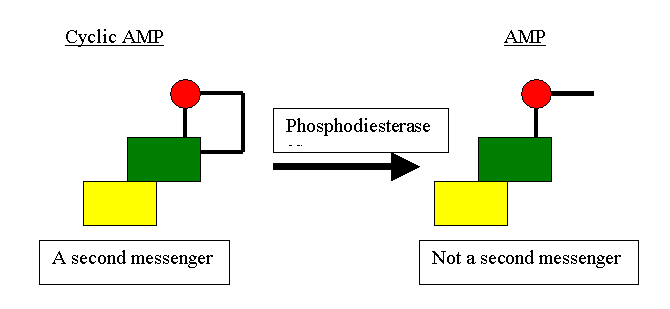
Tox Tudor has a good module on kinetics, but first, let's have a cup of coffee:
| Many of us note that when we are feeling tired. |  |
| A cup of coffee |  |
| seems to wake us up |  |
| Dilbert's Friend Wally |
A chemical, caffeine, in the coffee is a stimulant. It's the world's most popular psychotropic drug. You remember ATP is the chief energy molecule in cells.

Many cells, including neurons in the brain, have trans-membrane receptors that are activated by water soluble messengers, such as epinephrine. When they are activated, they set off a cascade of chemical reactions inside the cell that ultimately release"second messengers" within the cell. One of the commonest second messengers is cyclicAMP (aka cAMP). There is an enzyme inside the cell that converts ATP to cAMP. cAMP switches on cells, generally increases whatever they were doing, gets them moving faster. (Although its effect is different in different cells.) Conversely, cells need a way to switch back off, when the signal (the first messenger) is gone and the effect is no longer needed. Many cells do this by having an enzyme, phosphodiesterase, that breaks one of the connections of the cAMP, and ends its career as a second messenger.

So with that introduction, caffeine stimulates cells by inhibiting phosphodiesterase. Caffeine, a small lipophilic chemical, is absorbed from the GI tract and diffuses into cells. Caffeine has some first chemical cousins, theophylline and theobromine (which has no bromine in it, its just a name) that do the same thing, inhibit phosphodiesterase. Besides caffeine, tea contains theophylline and cocoa and chocolate have theobromine too.
In a scientific study of the relation between coffee and mood (or heart rate), what we really would like to know is: What is the concentration of caffeine at the active site of phosphodiesterase? So it is with all drugs and toxicants, we want to know the concentration at the particular cellular site of interest, where the action is. But that is hard to measure. In some cases it can be done experimentally, but it almost never can be measured in an intact animal. What is done in practice is to measure the concentration of the chemical in some convenient fluid and observe the effect of the chemical on the organ or organism, and relate that concentration to the effect. The fluid most often chosen is blood. Although other fluids, urine, cerebrospinal fluid, saliva, and exhaled air are used in some cases. So in kinetics we most often measure the concentration of a xenobiotic in the blood. And that is what we focus on here. We will relate that to effect later.
Tox Tudor does a good job of discussing DISTRIBUTION and go over that section, then come back here.
You recognize the one-compartment model from your other courses. Anytime you have an amount or concentration in a fixed volume and take out a fixed percentage in each time increment you have an exponential decrease - no matter if it is radioactivity or wastewater. The next page has an example from wastewater.